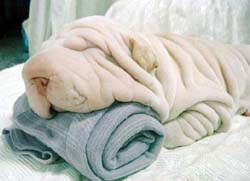|
Most
people add a pet to the family
on impulse. Either a dog wanders
into their lives or they see a
cute face they can't resist.
However, there are many
adoptable dogs at shelters who
need homes. If you have the
opportunity to select a puppy,
here are considerations in
choosing the best pet for your
family.
General
Considerations
Big? = Better
for protection and long runs.
Hugs are more people sized.
(Big puppy paws mean big adult
dog!)
Small? = Can
go anywhere easier, often more
childlike personality. Less
food expense and poop pick-up.
Short
Haired? = Better in
warm climates, quicker to bathe
and dry. May shed more.
Long Haired?
= (> 1 inch) Warmer, and
nice to hug. More grooming investment,
but also more options. Some
breeds, such as poodles and
maltese don't shed.
Sleep
Indoors? = Better bonding,
more stimulus to intelligence.
Better guarding.
Sleep Outdoors?
= Provide shelter, fresh food
and water. More problems with
excessive barking and digging.
May be more hyperactive and less
bonded to people.
The
best age to bring a pup home
is around seven to nine weeks
of age. This allows the pup
some socialization experience
with siblings, and still encourages
primary bonding with the new
human owner.
Health
Considerations
-
Don't adopt a puppy
who is ill at the time of
adoption - it is more likely
to be sick later also. Be
aware that 50% of pets
adopted from shelters get
sick due to exposure,
stress, and minimal
vaccinations.
-
Look for: Eye or nose thick
discharge; under or overbite;
harelip; lump at the belly
button.
- Avoid
droopy eyelids or mouths,
especially if either is discharging
anything.
-
Ask about the pup's
parents' health and
behavior.
-
Observe parent dog's
behavior for guarding, obedience,
hyperactivity.
-
Personality is partially inherited
- would you want to own the
parent dog?
-
Ask about frequency of vet
visits for the parents; any
allergies (excessive scratching
or skin lesions), repeated
ear infections? Checked for
Hip Dysplasia? Watch the adult
dog get up from laying. (Slow
or painful getting up?)
Puppy
Personality Testing
Some
studies have concluded these
tests are not reliable. Others
feel the puppy's basic
personality traits are measurable
by eight weeks of age. These
tests are intended to give a
general indication
of what personality to expect
from the adult dog. If possible,
test several pups at the same
time to get perspective on differences.
Try to test the same pup multiple
times before adoption. Only
extreme variations count.

Take
each puppy into a room away from
the mother and other pups. Write
down the test scores for each
pup. Identify each one by
number, or by its marking.
("Brown spot on left rear foot")
Personality
Test: In this neutral
setting, gently roll the pup
onto its back and hold it "chest
up" for about 30 seconds.
Don't talk. Act calm and
neutral and observe for struggling.
If
it:
Score
it: |
Struggles
constantly, growls or bites
"Strong Willed" These
pups need more consistent
discipline and handling. |
If
it:
Score
it: |
Acts
scared, rolls eyes, whines
or leaks urine
"Shy" It is
best to not coddle (reward).
Don't punish harshly.
Act happy lots! |
If
it:
Score it: |
Struggles
some, then relaxes and lays
quietly
"Balanced" (This
is most desirable) |
Following Test:
Carry the pup
to the center of the room. Put
it down facing you and walk
away. (Watch to see if the pup
follows you without encouragement.)
If
it:
Score
it: |
Ignores
you or wanders away
"Independent"
These pups need bonding
exercises. Harder to train. |
If
it:
Score
it: |
Cowers
or hides or follows hesitantly
"Shy" A little
reprimand goes a long way.
Get this pup into Puppy
Class. |
If
it:
Score it: |
Chases
you and tries to play bite
your foot
"Strong Willed" These
pups particularly benefit
from Puppy Class calming. |
If
it:
Score it: |
Follows
you with tail up and wagging
"Balanced" (This
is most desirable) |
If
itdoes any of the first three
choices initially, then call
in a happy voice, clap and slap
the floor to try to get the
pup to come. If it still will
not come and be friendly,
do not adopt.
Activity Test:
Observe the pup by itself and
with the litter for general
activity level.
If
it:
Score
it: |
Is
constantly in motion
"Active" These
pups grab your attention,
but can later tax patience. |
If
it:
Score
it: |
Is
constantly lethargic (unless
it just ate or is sickly)
"Slow" There
is a difference between
stupid (ugh) and very calm
(great!). |
If
it:
Score it: |
Is
interested and moves to
explore or play, then rests
"Balanced" (This
is generally most desirable) |
Retrieving Test:
A dog who retrieves is fun to
play with and much easier to
exercise. Take a small ball
or improvise with crumpled paper
and rubber band. Bounce it in
front of the pup, then roll
it away. Observe the puppy's
face closely without distracting
it.
If
it:
Score
it: |
Ignores
the ball totally
Low retrieving potential
(at least on that day and
time) |
If
it:
Score
it: |
Watches
the ball with interest,
but doesn't follow
Fair retrieving potential |
If
it:
Score it: |
Starts
out after the ball at all,
and especially if it follows
or touches the ball
Good retrieving potential |
If
it:
Score it: |
Brings
the ball back to you
A born retriever! |
Intelligence:
Intelligence is measured by
duration of eye focus, explorative
sniffing, ability to learn,
and tendency to explore new
areas.
|